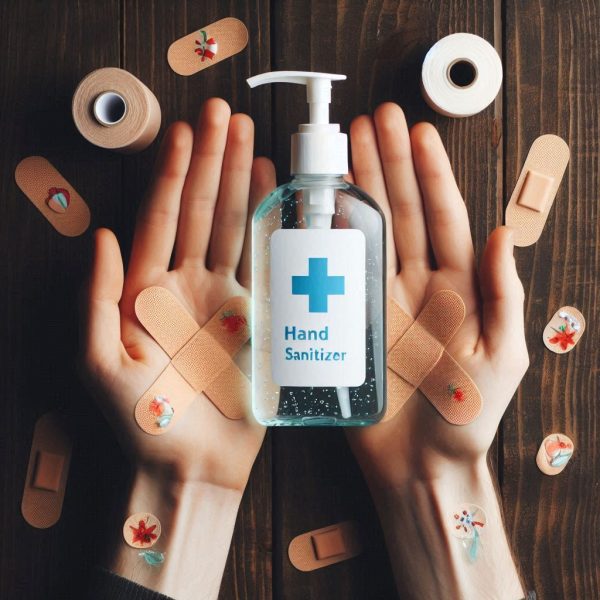Hand Sanitizer for Wound Care: Dangerous Mistakes You Must Avoid”

In today’s world, hand sanitizer for wound care might seem like a quick and easy solution, especially given its effectiveness in killing germs on our hands. However, using hand sanitizer for wound care is not only ineffective but can also cause irritation and slow the healing process. In this comprehensive guide, we’ll explore why hand sanitizer for wound care is not recommended and what safer, more effective alternatives you should use.
Understanding Hand Sanitizer and Its Limitations
Hand sanitizer is a liquid or gel designed to kill bacteria and viruses on the skin. Most hand sanitizers contain alcohol, either ethanol or isopropyl alcohol, as the primary active ingredient. While this makes it a great tool for disinfecting hands, it does not mean it is suitable for wound care.
Why Hand Sanitizer for Wound Care Is a Bad Idea
Despite its germ-killing properties, hand sanitizer for wound care is not recommended due to the following reasons:
1. High Alcohol Content Causes Pain and Irritation
Hand sanitizers typically contain 60% to 70% alcohol, which can cause severe stinging and discomfort when applied to an open wound. This pain is an indication that the sanitizer is irritating the tissue, which can hinder the healing process rather than help it.
2. Alcohol Dries Out the Wound
Alcohol has a drying effect on the skin, and wounds require a moist environment to heal properly. Applying hand sanitizer to a wound can lead to excessive dryness, which can cause cracking, increased irritation, and delayed recovery.
3. No Healing Properties
Unlike proper wound care treatments, hand sanitizers do not contain any ingredients that promote healing. Effective wound care requires a combination of cleaning, infection prevention, and moisture balance, none of which are provided by hand sanitizer.
The Science Behind Proper Wound Healing
To understand why hand sanitizer for wound care is ineffective, it’s important to know how wounds heal:
- Hemostasis: Blood clotting stops the bleeding.
- Inflammation: White blood cells fight infection and remove debris.
- Proliferation: New tissue forms to cover the wound.
- Maturation: The tissue strengthens and remodels over time.
Each of these stages requires a specific environment, which alcohol-based products like hand sanitizers can disrupt by causing excessive dryness and irritation.
Best Alternatives to Hand Sanitizer for Wound Care
Instead of hand sanitizer for wound care, consider these safe and effective alternatives:
1. Antiseptic Solutions
Antiseptics help disinfect wounds without causing excessive irritation. Recommended options include:
- Hydrogen Peroxide: Helps clean wounds but should be used sparingly as excessive use can damage healthy tissue.
- Iodine-Based Solutions (e.g., Betadine): Kills bacteria and is less irritating than alcohol.
2. Sterile Saline Solution
A sterile saline solution is one of the safest ways to clean a wound. It helps remove debris and bacteria without disrupting the healing process.
3. Wound Ointments
Applying an antibiotic ointment prevents infection and supports healing. Consider:
- Neosporin: Contains antibiotics that combat bacteria while keeping the wound moist.
- Petroleum Jelly: Creates a protective barrier and helps maintain moisture.
4. Hydrogel Dressings
Hydrogel dressings keep wounds moist, promote healing, and reduce pain. They are particularly effective for dry or painful wounds.
How to Properly Care for a Wound
To ensure a wound heals quickly and effectively, follow these best practices:
- Clean the Wound Properly – Use sterile saline or an antiseptic solution.
- Apply an Ointment – Use antibiotic ointments or petroleum jelly.
- Cover the Wound – Protect it with a sterile bandage.
- Monitor for Infection – Look for signs like redness, swelling, or pus.
- Avoid Picking at the Wound – Let it heal naturally to minimize scarring.
External Resources for Wound Care
For more information on proper wound care, visit these authoritative sources:
Conclusion
While hand sanitizer for wound care may seem like a quick solution, it is not the best choice. The high alcohol content causes irritation, dryness, and does not promote healing. Instead, use antiseptic solutions, sterile saline, wound ointments, or hydrogel dressings to ensure safe and effective wound care. By following proper wound care practices, you can prevent infections and speed up the healing process.
Do you have any questions about hand sanitizer for wound care or other wound care tips? Share your thoughts in the comments below!




